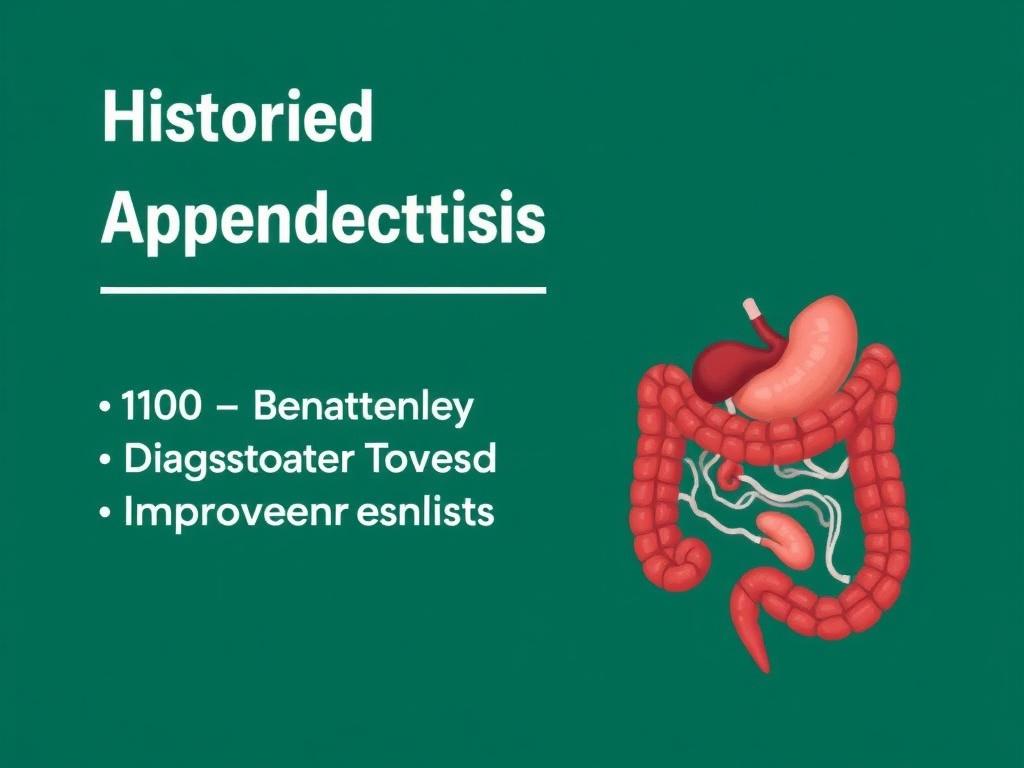The Early Years: Ancient Perspectives on Abdominal Pain
The story of appendicitis, as we understand it today, begins many centuries ago, even though the actual term and specific diagnosis came much later. Before medical science could isolate appendicitis as a separate condition, abdominal pain was often a mysterious and terrifying symptom. In ancient civilizations, such as Egypt, Greece, and Rome, abdominal distress was frequently attributed to imbalances in bodily humors, divine punishment, or an assortment of vague internal ailments. Physicians and healers documented symptoms resembling what we recognize as appendicitis but grouped them under the broader category of abdominal diseases.
One notable figure in early medical history was Hippocrates, the “Father of Medicine,” who observed various forms of abdominal pain. While he did not identify appendicitis specifically, his emphasis on clinical observation laid the groundwork for differentiating types of abdominal illnesses. For centuries, medical practitioners relied heavily on patient history and external signs, given the absence of advanced diagnostic tools.
Medieval and Renaissance Views: The Rise of Anatomical Exploration
During the medieval period, medical knowledge progression slowed in Europe, but in the Islamic Golden Age and later the Renaissance, significant advancements in anatomy and surgery set the stage for a better understanding of appendicitis. Physicians began to recognize that inflammation could arise from certain organs, though the appendix itself remained somewhat obscure, often regarded as a vestigial or non-essential organ.
One pivotal moment was the increased use of dissections in the Renaissance. Anatomists like Andreas Vesalius provided detailed studies of the human body that corrected many longstanding misconceptions from prior centuries. It was during this period that the appendix was clearly described, yet its function and pathology remained elusive. Inflammation of the appendix and its connection to acute abdominal emergencies were not yet fully realized.
The Appendix in Early Medical Texts
| Period | Understanding of the Appendix | Key Medical Figures |
|---|---|---|
| Ancient Times | Viewed as a mysterious, possibly useless organ with no clear function | Hippocrates (clinical observations) |
| Medieval Period | Little attention; abdominal pain regarded as general illness | Avicenna (writings on abdominal disease) |
| Renaissance | Anatomical description of appendix; function unknown | Andreas Vesalius (anatomy) |
19th Century: Identifying Appendicitis as a Distinct Condition
The 19th century marked a turning point for the historical understanding of appendicitis. Advances in pathology and surgery allowed physicians to correlate clinical symptoms with internal findings more accurately. The condition we now call appendicitis began to be recognized as a distinct disease entity rather than a vague form of abdominal pain or indigestion.
In 1886, Reginald Fitz, an American pathologist, published one of the first comprehensive descriptions of acute appendicitis. Fitz emphasized that inflammation of the appendix was a leading cause of right lower abdominal pain and could be fatal if left untreated. His paper helped alert the medical community to the importance of timely diagnosis and surgical intervention.
During this era, a number of other doctors began to report successful surgical removals of inflamed appendices, and appendectomy started to become a more common and life-saving operation. However, risk and mortality rates were still high due to infection, limited anesthesia, and a lack of antibiotics.
Key Advances in the 19th Century
- Identification of appendicitis as a specific disease (Fitz, 1886)
- Development of appendectomy as standard treatment
- Improvements in surgical techniques and anesthesia
- Recognition of symptoms such as right lower quadrant pain, nausea, and fever
20th Century: Diagnostic Tools and Surgical Improvements

With the dawn of the 20th century, the historical understanding of appendicitis grew exponentially. Medical science introduced revolutionary diagnostic tools such as X-rays and later ultrasound and CT scans, which allowed doctors to diagnose appendicitis with far greater accuracy than ever before. This shift dramatically reduced both diagnostic errors and surgical delays.
The development and widespread use of antibiotics transformed postoperative care and further reduced the complications associated with appendectomy. Surgeons moved from large open incisions to minimally invasive laparoscopic surgery beginning in the late 20th century, which resulted in quicker recoveries and fewer complications.
Technological Milestones in Appendicitis Care
| Decade | Technological Advance | Impact on Appendicitis Treatment |
|---|---|---|
| 1900s–1920s | Introduction of X-rays | Better anatomical visualization but limited for soft tissue |
| 1970s | Ultrasound imaging | Non-invasive diagnosis helpful in children and pregnant women |
| 1990s | CT scans | Highly accurate diagnosis; reduced unnecessary surgeries |
| 1990s–2000s | Laparoscopic appendectomy | Less invasive surgery, shorter hospital stays |
Contemporary Understanding: Appendicitis in the 21st Century
Today, appendicitis is one of the most common causes of acute abdomen and emergency surgery worldwide. Although much progress has been made since its initial historical conception, medical research continues to explore the causes, symptoms, and best treatment options for appendicitis.
Scientists have discovered that appendicitis is most often caused by blockage of the appendix lumen, typically by fecaliths, lymphoid hyperplasia, or rarely tumors and parasites. This blockage causes bacterial overgrowth and inflammation, which can rapidly progress to rupture if untreated.
There is also ongoing debate regarding treatment approaches for uncomplicated appendicitis. Some studies suggest that antibiotics alone could be enough in certain cases, sparking a rethink of the historical assumption that surgery is always necessary. Despite these debates, appendectomy remains the gold standard treatment worldwide, benefiting from decades of surgical advancement.
Common Symptoms of Appendicitis
- Abdominal pain starting near the navel then shifting to right lower quadrant
- Nausea and vomiting
- Fever
- Loss of appetite
- Localized tenderness and rebound pain
Modern Treatment Options
| Treatment | Description | Advantages | Disadvantages |
|---|---|---|---|
| Appendectomy (Surgery) | Removal of inflamed appendix via open or laparoscopic method | Definitive treatment, low recurrence risk | Invasive, surgical risks, recovery time |
| Antibiotic Therapy | Use of antibiotics to treat uncomplicated appendicitis | Non-invasive, avoids surgery | Risk of recurrence, not suitable for complicated cases |
The Appendix: From Vestigial Organ to Immune Function
Another fascinating aspect of the historical understanding of appendicitis involves shifting perceptions about the appendix itself. Once considered a useless relic of evolution, modern science suggests that the appendix may play a role in the immune system, especially in early life. It is thought to serve as a reservoir for beneficial gut bacteria and contribute to the mucosal immune response.
This evolving understanding partially explains why some people with chronic appendiceal conditions experience different symptoms and recovery trajectories. Although inflammation requires removal, the appendix is no longer dismissed as a meaningless organ, but rather appreciated for its subtle biological contributions.
Summary of Appendix Functions
- Acts as a storehouse for beneficial gut bacteria
- Participates in immune responses via lymphoid tissue
- Possibly contributes to early development of gut-associated immunity
- Potentially involved in maintaining microbiome balance after infections
Learning from History: How Understanding Appendicitis Has Shaped Surgery and Diagnosis
Reflecting on the historical journey of appendicitis reveals how medicine evolves through observation, technology, and scientific inquiry. From vague ancient descriptions to the sharp diagnostic clarity and surgical precision of today, the path to understanding appendicitis encapsulates the progress in human health care.
This history also teaches us the importance of listening carefully to symptoms, valuing anatomical knowledge, and embracing new technologies. It highlights how diseases once seen as mysterious can become manageable, even curable, through persistent medical efforts.
Key Takeaways from This Historical Journey
- Clinical observation remains fundamental to diagnosis.
- Anatomical knowledge is essential for understanding disease mechanisms.
- Technological advances can transform diagnosis and treatment.
- Medical knowledge is dynamic and subject to revision.
- Surgery, once risky, now can be safe and minimally invasive.
Contemporary Challenges and Future Directions

Despite significant progress, challenges remain in the diagnosis and treatment of appendicitis. Not all cases present typically, which can complicate early identification. Additionally, some patients experience recurrent or chronic appendicitis, raising questions about the best long-term management strategies.
Research into less invasive diagnostics, tailored antibiotic protocols, and understanding the role of the appendix in overall health continues. Emerging fields like genomics and microbiome science may reveal even more about why appendicitis occurs and how best to prevent or treat it.
Innovation in healthcare delivery, such as telemedicine and artificial intelligence diagnostic tools, also promises to make appendicitis care faster, more accurate, and more accessible worldwide.
Conclusion
The historical understanding of appendicitis is a fascinating journey through medicine’s past, showcasing how human curiosity, scientific rigor, and technological advancement combine to conquer disease. From ancient times, when abdominal pain was poorly understood and often fatal, to today’s precise diagnosis and effective treatment strategies, appendicitis has taught us invaluable lessons about the importance of anatomy, observation, and innovation. While the appendix itself was long thought to be insignificant, modern insights reveal its subtle contributions to health, reminding us that even the smallest organs can have significant roles. As medicine continues to evolve, the story of appendicitis serves as a powerful example of progress and hope in the face of medical challenges. Through understanding this history deeply, both clinicians and patients can appreciate the strides made and the continuing efforts to improve care for this common yet complex condition.



